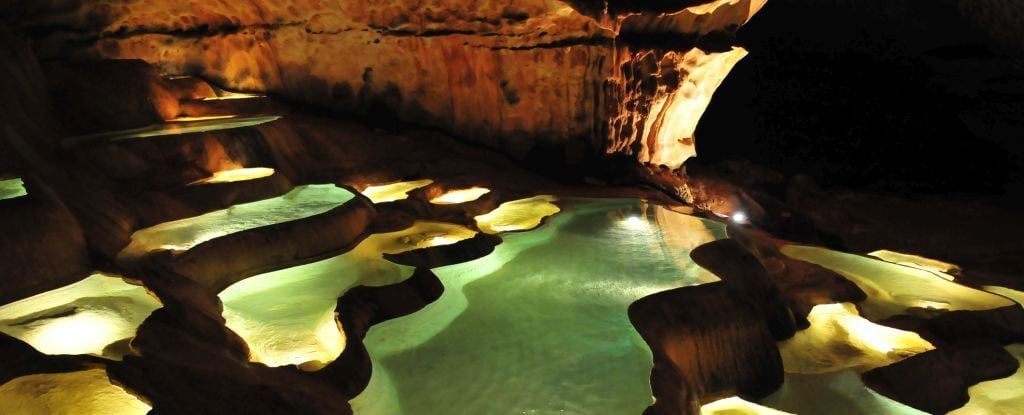The Saint-Marcel cave network in southern France has long captivated the imaginations of explorers and scientists alike. Its extensive passageways and deep pits present a formidable challenge even to modern cavers equipped with the latest gear. Yet, a recent study has uncovered evidence that humans, some 8,000 years ago, ventured more than a mile into the heart of this subterranean world. This remarkable feat raises profound questions about the capabilities and motivations of these early adventurers.
The Mystery of the Broken Speleothems
The discovery of broken speleothems—stalagmites and stalactites formed from mineral deposits—deep within the Saint-Marcel caves suggests a level of human activity that has gone largely unappreciated until now. For over a century, these broken formations were attributed to the careless hands of nineteenth-century tourists. However, the recent study led by geomorphologist Jean-Jacques Delannoy from the University of Savoy Mont Blanc – Chambery, France, has shed new light on their true antiquity.
Delannoy and his team meticulously mapped the distribution of the broken speleothem pieces and conducted uranium and thorium isotope dating to determine their age. The results were astonishing: the breakages began around 10,000 years ago, with the oldest pieces used in structures dating back to about 8,000 years ago. This timeline significantly predates the arrival of those early tourists, pointing instead to a prehistoric human presence deep within the cave.
The researchers faced skepticism when they first proposed that the broken speleothems could be much older than previously thought. It was, after all, a common practice for early cave explorers to take pieces of the cave as souvenirs. But the evidence was compelling. The ancient breakages were made 5-10cm above the cave floor, unlike the flush cuts made by modern tools. Furthermore, the pieces on the ground appeared to be deliberately arranged, some held in place with smaller chunks, suggesting a purposeful activity rather than random vandalism.
The isotope dating also revealed that the speleothems themselves formed between 125,000 and 70,000 years ago. The youngest signs of significant stalagmite regrowth on a previously broken stump were dated to just over 3,000 years ago. This timeline not only confirms the ancient human interaction with the cave but also provides a window into the environmental conditions of the cave over tens of thousands of years.
Delannoy’s findings have been met with enthusiasm by the archaeological community. Marie-Hélène Moncel, director of research at the National Museum of Natural History in Paris, notes that the study indicates early humans moved into caves more than previously thought. The Saint-Marcel cave network, with its challenging terrain, suggests that these prehistoric people had a remarkable understanding of cave navigation and lighting techniques.
The question of how these early humans illuminated their way through the dark, treacherous cave passages remains a mystery. Delannoy’s team is analyzing soot deposits found in the cave, some of which date back to the same period as the stalagmite arrangements. These could provide clues about the use of torches or oil lamps by the cave’s ancient visitors.
Despite the progress in understanding the physical evidence of human presence in the Saint-Marcel caves, the motivations behind the stalagmite breakage and arrangement remain elusive. Delannoy concedes that some questions, such as why humans felt compelled to venture so deep into the earth and manipulate its natural formations, may never be answered. We can only speculate about the cultural or spiritual significance these activities may have held for our ancestors.
The Saint-Marcel cave network is not unique in its evidence of ancient human activity. The nearby Bruniquel cave, for example, contains Neanderthal-built stalagmite structures dating back some 170,000 years. These findings collectively point to a rich and complex history of human interaction with the subterranean world, far beyond what was previously imagined.
As we delve deeper into the mysteries of the Saint-Marcel cave network, we are reminded of the fragility and wonder of these natural formations. Speleothems like those found in the Mammoth Cave in the United States are a testament to the slow and delicate processes that shape our planet’s underground landscapes. Visitors to such caves are urged to tread lightly, respecting the irreplaceable treasures that have taken millennia to form.
The broken stalagmites of Saint-Marcel serve as a poignant reminder of the deep connection between humanity and the earth. As we continue to explore and understand our planet’s past, we must also consider our role in preserving its future. The careful study of these ancient cave formations not only enriches our knowledge of human history but also underscores the importance of protecting these delicate ecosystems for generations to come.

The Significance of Stalagmite Arrangements and Future Research
The broken stalagmites in the Saint-Marcel cave network not only tell a story of human ingenuity and adaptability but also open a gateway to understanding the cultural practices of our ancestors. The meticulous arrangement of these ancient formations suggests a level of sophistication in behavior and possibly a ritualistic or symbolic purpose behind their placement. The research conducted by Jean-Jacques Delannoy and his team has provided a foundation for future explorations into the depths of human history and our relationship with the natural world.
As we consider the significance of these findings, it is important to reflect on the technological advancements that would have been necessary for such an expedition. The early humans who ventured into the Saint-Marcel caves would have required a reliable source of light to navigate the pitch-black environment. The presence of soot deposits, which Delannoy’s team is currently analyzing, may offer insights into the types of lighting used, whether torches or oil lamps. This research could revolutionize our understanding of prehistoric technology and innovation.
The question of why these early humans chose to break and arrange the stalagmites remains one of the most intriguing mysteries. While Delannoy acknowledges that we may never fully understand their motivations, the act of altering their environment in such a deliberate way indicates a level of abstract thinking and purpose. It is possible that these formations held a ceremonial or navigational purpose, or they may have been part of a larger pattern or message left by these ancient peoples.
The implications of these findings extend beyond the Saint-Marcel cave network. The nearby Bruniquel cave, with its Neanderthal-built stalagmite structures dating back some 170,000 years, suggests that the practice of modifying cave environments is a deep-seated aspect of human behavior. This continuity of subterranean exploration and alteration challenges our perceptions of prehistoric humans and their capabilities.
Future research in the Saint-Marcel caves and similar sites will likely focus on further unraveling the complex behaviors associated with these ancient activities. Archaeologists and speleologists will continue to work together, employing advanced dating techniques and spatial analysis to piece together the story of human presence in these enigmatic spaces. The study of cave art, tool marks, and other archaeological evidence will complement the speleothem research, providing a more holistic view of prehistoric life.
As we move forward, it is crucial to approach these sites with a sense of reverence and responsibility. The delicate nature of speleothems, as seen in the Mammoth Cave formations, reminds us of the fragility of these underground wonders. The impact of human touch, whether from thousands of years ago or from modern visitors, can have lasting consequences on these slow-growing structures. It is our duty to preserve these sites, not only for their scientific value but also as a connection to our shared human heritage.
The broken stalagmites of the Saint-Marcel cave network serve as a testament to the curiosity and adaptability of early humans. Their actions within the cave have left us with a rich tapestry of questions and a legacy that continues to inspire awe and wonder. As we delve deeper into the past, we must also look to the future, ensuring that these ancient marvels are protected for the generations that will follow in our footsteps, seeking answers to the same timeless questions about our origins and our place within the natural world.
Related posts:
Broken stalagmites show humans explored deep cave 8,000 years ago News
Deep in a Cave in France Neanderthals Constructed Mysterious Ring Structures 176,000 Years Ago
Divers race to save prehistoric art from undersea cave others have died trying to reach





